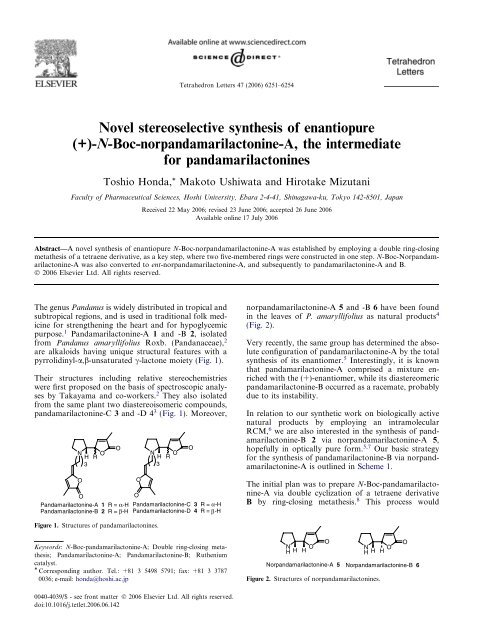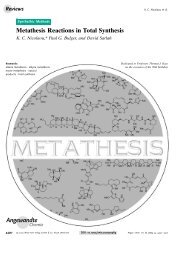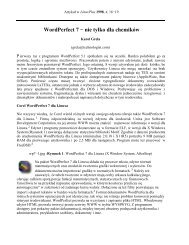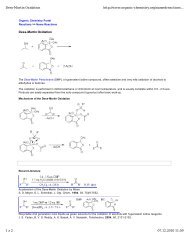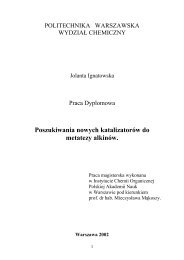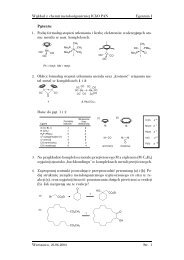Novel stereoselective synthesis of enantiopure ... - The Grela's Group
Novel stereoselective synthesis of enantiopure ... - The Grela's Group
Novel stereoselective synthesis of enantiopure ... - The Grela's Group
Create successful ePaper yourself
Turn your PDF publications into a flip-book with our unique Google optimized e-Paper software.
Tetrahedron Letters 47 (2006) 6251–6254<br />
<strong>Novel</strong> <strong>stereoselective</strong> <strong>synthesis</strong> <strong>of</strong> <strong>enantiopure</strong><br />
(+)-N-Boc-norpandamarilactonine-A, the intermediate<br />
for pandamarilactonines<br />
Toshio Honda, * Makoto Ushiwata and Hirotake Mizutani<br />
Faculty <strong>of</strong> Pharmaceutical Sciences, Hoshi University, Ebara 2-4-41, Shinagawa-ku, Tokyo 142-8501, Japan<br />
Received 22 May 2006; revised 23 June 2006; accepted 26 June 2006<br />
Available online 17 July 2006<br />
Abstract—A novel <strong>synthesis</strong> <strong>of</strong> <strong>enantiopure</strong> N-Boc-norpandamarilactonine-A was established by employing a double ring-closing<br />
metathesis <strong>of</strong> a tetraene derivative, as a key step, where two five-membered rings were constructed in one step. N-Boc-Norpandamarilactonine-A<br />
was also converted to ent-norpandamarilactonine-A, and subsequently to pandamarilactonine-A and B.<br />
Ó 2006 Elsevier Ltd. All rights reserved.<br />
<strong>The</strong> genus Pandanus is widely distributed in tropical and<br />
subtropical regions, and is used in traditional folk medicine<br />
for strengthening the heart and for hypoglycemic<br />
purpose. 1 Pandamarilactonine-A 1 and -B 2, isolated<br />
from Pandanus amaryllifolius Roxb. (Pandanaceae), 2<br />
are alkaloids having unique structural features with a<br />
pyrrolidinyl-a,b-unsaturated c-lactone moiety (Fig. 1).<br />
<strong>The</strong>ir structures including relative stereochemistries<br />
were first proposed on the basis <strong>of</strong> spectroscopic analyses<br />
by Takayama and co-workers. 2 <strong>The</strong>y also isolated<br />
from the same plant two diastereoisomeric compounds,<br />
pandamarilactonine-C 3 and -D 4 3 (Fig. 1). Moreover,<br />
O<br />
N O<br />
N O<br />
H R<br />
H R<br />
3 3<br />
O<br />
O<br />
Pandamarilactonine-A 1 R = α-H<br />
Pandamarilactonine-B 2 R = β-H<br />
O<br />
O<br />
O<br />
Pandamarilactonine-C 3 R = α-H<br />
Pandamarilactonine-D 4 R = β-H<br />
norpandamarilactonine-A 5 and -B 6 have been found<br />
in the leaves <strong>of</strong> P. amaryllifolius as natural products 4<br />
(Fig. 2).<br />
Very recently, the same group has determined the absolute<br />
configuration <strong>of</strong> pandamarilactonine-A by the total<br />
<strong>synthesis</strong> <strong>of</strong> its enantiomer. 5 Interestingly, it is known<br />
that pandamarilactonine-A comprised a mixture enriched<br />
with the (+)-enantiomer, while its diastereomeric<br />
pandamarilactonine-B occurred as a racemate, probably<br />
due to its instability.<br />
In relation to our synthetic work on biologically active<br />
natural products by employing an intramolecular<br />
RCM, 6 we are also interested in the <strong>synthesis</strong> <strong>of</strong> pandamarilactonine-B<br />
2 via norpandamarilactonine-A 5,<br />
hopefully in optically pure form. 5,7 Our basic strategy<br />
for the <strong>synthesis</strong> <strong>of</strong> pandamarilactonine-B via norpandamarilactonine-A<br />
is outlined in Scheme 1.<br />
<strong>The</strong> initial plan was to prepare N-Boc-pandamarilactonine-A<br />
via double cyclization <strong>of</strong> a tetraene derivative<br />
B by ring-closing metathesis. 8 This process would<br />
Figure 1. Structures <strong>of</strong> pandamarilactonines.<br />
Keywords: N-Boc-pandamarilactonine-A; Double ring-closing metathesis;<br />
Pandamarilactonine-A; Pandamarilactonine-B; Ruthenium<br />
catalyst.<br />
* Corresponding author. Tel.: +81 3 5498 5791; fax: +81 3 3787<br />
0036; e-mail: honda@hoshi.ac.jp<br />
N<br />
H<br />
O<br />
H H<br />
O<br />
Norpandamarilactonine-A 5<br />
N<br />
H<br />
Figure 2. Structures <strong>of</strong> norpandamarilactonines.<br />
O<br />
H H<br />
O<br />
Norpandamarilactonine-B 6<br />
0040-4039/$ - see front matter Ó 2006 Elsevier Ltd. All rights reserved.<br />
doi:10.1016/j.tetlet.2006.06.142
6252 T. Honda et al. / Tetrahedron Letters 47 (2006) 6251–6254<br />
Pandamarilactonine-B<br />
N O<br />
H H<br />
Boc<br />
C<br />
BocHN<br />
O<br />
N O<br />
H H<br />
3 1) Deprotection<br />
2) N-alkylation<br />
O<br />
A<br />
O<br />
O<br />
O<br />
O<br />
known<br />
RCM<br />
N-Boc-pandamarilactonine-A<br />
O<br />
N O<br />
H H<br />
Boc<br />
N<br />
Boc<br />
CHO<br />
NBoc<br />
Gaener aldehyde<br />
proceed through the formation <strong>of</strong> a dihydropyrrole C,<br />
followed by further cyclization <strong>of</strong> the remaining diene<br />
to a butenolide. Such double cyclization <strong>of</strong> a tetraene<br />
derivative constructing two five-membered rings, simultaneously,<br />
has been little focused on the <strong>synthesis</strong> <strong>of</strong> natural<br />
products. Moreover, the stereochemistry presented<br />
in a tetraene compound would be intact under the reaction<br />
conditions employed, to lead to the desired compound,<br />
<strong>stereoselective</strong>ly, in an optically active form.<br />
Tetraene derivative B would be derived from the known<br />
amine A by manipulation <strong>of</strong> the functional groups.<br />
To prepare the requisite substrates for the norpandamarilactonine-A<br />
project, we decided to employ a readily<br />
available L-serine as the chiral starting material, since<br />
the absolute configuration <strong>of</strong> pandamarilactonine-B<br />
had not been determined yet, when we started this<br />
<strong>synthesis</strong>.<br />
L-Serine methyl ester hydrochloride was converted to<br />
the known compound A, 9 which, on allylation with allyl<br />
iodide and NaH in DMF gave N-allyl compound 7. 10<br />
Removal <strong>of</strong> the acetonide in 7 on treatment with p-toluenesulfonic<br />
acid gave diol 8. After selective protection <strong>of</strong><br />
the primary alcohol <strong>of</strong> 8 with tert-butyldimethylsilyl<br />
chloride, the resulting silyl ether 9 was protected as its<br />
MOM ether 10, which was further converted to primary<br />
alcohol 11 by treatment with TBAF. It was appreciated<br />
that the oxidation <strong>of</strong> 11 with Dess–Martin periodinane<br />
proceeded smoothly to give aldehyde 12, which,<br />
on methylenation with methyltriphenylphosphonium<br />
bromide and n-BuLi in the usual manner afforded the<br />
desired triene 13, in good yield.<br />
After the two-step manipulation <strong>of</strong> the protecting<br />
groups in 13, involving removal <strong>of</strong> the Boc and MOM<br />
groups by acid hydrolysis, followed by protection <strong>of</strong><br />
the resulting amino group <strong>of</strong> 14 with Boc 2 O, the resulting<br />
secondary alcohol 15 was esterified with methacrylic<br />
O<br />
O<br />
O<br />
1) RCM<br />
2) selective<br />
reduction<br />
H 2 N<br />
OH<br />
CO 2 H<br />
L-serine<br />
Scheme 1. Retrosynthetic analysis <strong>of</strong> ent-pandamarilactonine-B.<br />
B<br />
acid in the presence <strong>of</strong> DCC and DMAP to provide the<br />
desired tetraene derivative 16 (Scheme 2).<br />
With the requisite tetraene available, a study was made<br />
for the best conditions for a double RCM. 11<br />
First, we attempted a double RCM for 16 using<br />
10 mol % <strong>of</strong> Grubbs’ 2nd-generation ruthenium catalyst<br />
12 in benzene at 80 °C for 20 h; however, the desired<br />
compound 17 was isolated in only 2% yield. <strong>The</strong> major<br />
products were found to be mono-cyclized products 18<br />
and 20, in 25% and 25% yields, respectively (Table 1,<br />
entry 1). When this reaction was carried out using<br />
10 mol % <strong>of</strong> the Hoveyda catalyst 13 in benzene at<br />
80 °C for 20 h, bicyclic tetrahydropyridine derivative<br />
19 was isolated as the major product, in 28% yield,<br />
together with the desired compound 17 (6%), pyrrolidine<br />
derivative 18 (2%), and tetrahydropyridine derivative<br />
20 (24%) (Table 1, entry 2). Interestingly, a similar reaction<br />
<strong>of</strong> 16 with 10 mol % <strong>of</strong> the Hoveyda catalyst at<br />
60 °C gave the desired compound 17, in 73% yield, together<br />
with 20 (23%) (Table 1, entry 4). Even with the<br />
use <strong>of</strong> 5 mol % <strong>of</strong> the Hoveyda catalyst, RCM <strong>of</strong> 16 in<br />
benzene at 60 °C for 20 h furnished butenolide 17, in<br />
24% yield accompanied with pyrrolidine 18 in 44% yield<br />
(Table 1, entry 3). <strong>The</strong>se results obviously indicated<br />
that the products ratio depended on the reaction<br />
temperature, and butenolide 17 might be the kineticallycontrolled<br />
product, whereas 19 would be the thermodynamically-controlled<br />
product.<br />
To prove this hypothesis, butenolide 17 was subjected to<br />
further RCM in benzene at 80 °C for 20 h in the presence<br />
<strong>of</strong> 10 mol % <strong>of</strong> the Hoveyda catalyst to give 19 in<br />
82% yield as expected (Scheme 3).<br />
On screening a variety <strong>of</strong> reaction conditions for RCM<br />
<strong>of</strong> 16, we found that the use <strong>of</strong> 10 mol % <strong>of</strong> the Grela<br />
BocHN<br />
d<br />
77%<br />
e<br />
95%<br />
h<br />
A<br />
O<br />
RO<br />
O<br />
O<br />
96% 85%<br />
N<br />
Boc<br />
OMOM N<br />
Boc<br />
OMOM N<br />
Boc<br />
OMOM<br />
10 R = TBDMS<br />
11 R = H<br />
12<br />
13<br />
73% N OH 86%<br />
R<br />
i<br />
76%<br />
14 R = H<br />
15 R = Boc<br />
O<br />
a<br />
b<br />
O<br />
63% N<br />
92%<br />
Boc<br />
f<br />
j<br />
7<br />
N<br />
Boc<br />
16<br />
g<br />
O<br />
c<br />
93%<br />
RO<br />
O<br />
N<br />
Boc<br />
OH<br />
8 R = H<br />
9 R = TBDMS<br />
Scheme 2. Reagents and conditions: (a) allyl iodide, NaH, DMF, 0 °C<br />
to rt, 2 h; (b) p-TsOH, MeOH, rt, 3 h; (c) TBDMSCl, imidazole, DMF,<br />
rt, 3 h; (d) MOMCl, i Pr 2 NEt, DMAP, CH 2 Cl 2 ,0°C to rt, 8 h; (e)<br />
TBAF, THF, rt, 10 h; (f) Dess–Martin periodinane, CH 2 Cl 2 , rt, 1 h; (g)<br />
CH 3 P + Ph 3 Br , n-BuLi, THF, 78 °C, 8 h; (h) 10% HCl, MeOH,<br />
70 °C, 2 h; (i) Boc 2 O, Et 3 N, THF, rt, 8 h; (j) methacrylic acid, DCC,<br />
DMAP, CH 2 Cl 2 ,0°C to rt, 16 h.
T. Honda et al. / Tetrahedron Letters 47 (2006) 6251–6254 6253<br />
Table 1. RCM for tetraene 16<br />
N<br />
Boc<br />
Entry<br />
16<br />
O<br />
Catalyst<br />
(mol %)<br />
O<br />
catalyst<br />
benzene<br />
20 h<br />
N<br />
Boc<br />
N<br />
Boc<br />
catalyst 14 in benzene at 60 °C for 20 h afforded the desired<br />
compound 17, in 76% yield (Table 1, entry 7).<br />
Keeping the reaction temperature at 60 °C, butenolide<br />
17 could be isolated from the reaction mixture even with<br />
the use <strong>of</strong> 5 mol % <strong>of</strong> the Grela catalyst, in 70% yield<br />
(Table 1, entry 6). When this RCM was carried out at<br />
room temperature in the presence <strong>of</strong> 10 mol % <strong>of</strong> the<br />
Grela catalyst for 20 h, mono-cyclized pyrrolidine 18<br />
was isolated as the major product, in 64% yield (Table<br />
1, entry 5). <strong>The</strong> results obtained for RCM <strong>of</strong> 16 are summarized<br />
in Table 1.<br />
<strong>The</strong> observed formation <strong>of</strong> tetrahydropyridine derivative<br />
20 would be rationalized by assuming that the Rucarbenoid,<br />
firstly generated from a reaction <strong>of</strong> the terminal<br />
olefin in the N-allyl moiety with ruthenium catalyst,<br />
would react with another mono-substituted olefin in the<br />
acylated allyl alcohol group, competitively.<br />
Mono-cyclized pyrrolidine 18 could also be converted to<br />
17 by further reaction with 10 mol % <strong>of</strong> the Hoveyda<br />
catalyst in benzene at 60 °C for 20 h, in 84% yield<br />
(Scheme 4). <strong>The</strong> structure <strong>of</strong> 17 was unambiguously<br />
determined by X-ray crystallographic analysis. 15<br />
O<br />
Temperature<br />
(°C)<br />
O<br />
O<br />
O<br />
N<br />
Boc<br />
17 18<br />
N<br />
Boc<br />
O<br />
19 20<br />
O<br />
O<br />
Product yield (%)<br />
17 18 19 20<br />
1 Grubbs (10) 80 2 25 7 25<br />
2 Hoveyda (10) 80 6 2 28 24<br />
3 Hoveyda (5) 60 24 44 0 22<br />
4 Hoveyda (10) 60 73 3 0 23<br />
5 Grela (10) rt 14 64 0 22<br />
6 Grela (5) 60 70 5 0 25<br />
7 Grela (10) 60 76 2 0 22<br />
MesN NMes<br />
Cl<br />
Cl<br />
Ru<br />
Ph<br />
PCy 3<br />
.<br />
Grubbs cat.<br />
N<br />
Boc<br />
O<br />
O<br />
MesN NMes<br />
Cl<br />
Ru<br />
Cl<br />
O<br />
Hoveyda cat.<br />
MesN NMes<br />
Cl<br />
Ru<br />
Cl<br />
O<br />
Grela cat.<br />
N<br />
Boc<br />
17 19<br />
Scheme 3. Conversion <strong>of</strong> 17–19.<br />
Hoveyda catalyst (10 mol %)<br />
benzene, 80 °C, 20 h (82%)<br />
O<br />
O<br />
NO 2<br />
O<br />
N<br />
Boc<br />
18<br />
O<br />
O<br />
Scheme 4. Conversion <strong>of</strong> 18–17.<br />
N<br />
Boc<br />
17<br />
O<br />
TMSOTf<br />
2,6-lutidine<br />
CH 2 Cl 2 , -20 °C<br />
10 min, (43%)<br />
O<br />
Hoveyda catalyst (10 mol %)<br />
benzene, 60 °C, 20 h (84%)<br />
Wilkinson catalyst, H 2 (5 atm)<br />
CH 2 Cl 2 , rt, 18 h (95%)<br />
Selective reduction <strong>of</strong> the double bond in the pyrrolidine<br />
ring <strong>of</strong> 17 was successfully achieved by catalytic hydrogenation<br />
with the Wilkinson catalyst under 5 atm <strong>of</strong><br />
hydrogen to afford (+)-N-Boc-norpandamarilactonine-<br />
A 21, mp 75–77 °C. [a] D 51.1 (c 1.0, CHCl 3 ), in 95%<br />
yield (Scheme 5).<br />
Treatment <strong>of</strong> 21 with trimethylsilyl triflate provided entnorpandamarilactonine-A<br />
ent-5, [a] D +55.0 (c 0.82,<br />
CHCl 3 ) {lit., 5 +80.2 (c 0.79, CHCl 3 )}, as the sole product,<br />
which, however, gradually became a mixture with<br />
norpandamarilactonine-B 6, due to its rapid partial epimerization.<br />
16 Although a similar instability <strong>of</strong><br />
norpandamarilactonines was already observed in the<br />
previous syntheses, 5,7 conversion <strong>of</strong> ent-5 to pandamarilactonine-B<br />
2 by coupling with iodide 22, 3 was attempted<br />
according to Takayama’s procedure, 5 and we<br />
could isolate both racemic pandamarilactonine-A and<br />
optically active pandamarilactonine-B in 15% and 62%<br />
yields, respectively. <strong>The</strong> spectroscopic data <strong>of</strong> the synthesized<br />
pandamarilactonine-B, [a] D +13.1 (c 0.72,<br />
CHCl 3 ), were identical with those provided by Pr<strong>of</strong>essor<br />
Takayama.<br />
In summary, we were able to develop a novel chiral <strong>synthesis</strong><br />
<strong>of</strong> (+)-N-Boc-norpandamarilactonine-A in an<br />
<strong>enantiopure</strong> form by means <strong>of</strong> RCM <strong>of</strong> the tetraene<br />
derivative, where the desired bis-five-membered rings<br />
were constructed in one step, in high yield. It is noteworthy<br />
that the cyclization product ratios depend on the<br />
reaction conditions, especially on reaction temperature.<br />
<strong>The</strong> desired bis-five-membered compound 17 is supposed<br />
to be a kinetically-controlled product.<br />
Acknowledgements<br />
N<br />
Boc<br />
We are grateful to Pr<strong>of</strong>essor H. Takayama, Graduate<br />
School <strong>of</strong> Pharmaceutical Sciences, Chiba University,<br />
for the generous gifts <strong>of</strong> 1 H and 13 C NMR spectra <strong>of</strong><br />
17<br />
N<br />
Boc<br />
I<br />
O<br />
O<br />
22<br />
ent-5<br />
1 + 2<br />
Ag 2 CO 3 , CH 3 CN<br />
rt, 24 h<br />
(15% for 1, 62% for 2)<br />
Scheme 5. Synthesis <strong>of</strong> N-Boc-norpandamarilactonine-A and its<br />
conversion to pandamarilactonines.<br />
21<br />
O<br />
O<br />
O<br />
O
6254 T. Honda et al. / Tetrahedron Letters 47 (2006) 6251–6254<br />
norpandamarilactonines and pandamarilactonines. This<br />
work was supported by the Ministry <strong>of</strong> Education,<br />
Culture, Sports, Science and Technology <strong>of</strong> Japan.<br />
References and notes<br />
1. Peungvicha, P.; Temsiririrkul, R.; Prasain, J. K.; Tezuka,<br />
Y.; Kadota, S.; Thirawarapan, S. S.; Watanabe, H. J.<br />
Ethnopharmacol. 1998, 62, 79–84.<br />
2. Takayama, H.; Ichikawa, T.; Kuwajima, T.; Kitajima, M.;<br />
Seki, H.; Aimi, N.; Nonato, M. G. J. Am. Chem. Soc.<br />
2000, 122, 8635–8639.<br />
3. Takayama, H.; Ichikawa, T.; Kitajima, M.; Nonato, M.<br />
G.; Aimi, N. Chem. Pharm. Bull. 2002, 50, 1303–1304.<br />
4. Takayama, H.; Ichikawa, T.; Kitajima, M.; Nonato, M.<br />
G.; Aimi, N. J. Nat. Prod. 2001, 64, 1224–1225.<br />
5. Takayama, H.; Sudo, R.; Kitajima, M. Tetrahedron Lett.<br />
2005, 46, 5795–5797.<br />
6. (a) Mizutani, H.; Watanabe, M.; Honda, T. Tetrahedron<br />
2002, 58, 8929–8936; (b) Honda, T.; Namiki, H.; Kaneda,<br />
K.; Mizutani, H. Org. Lett. 2004, 6, 87–89; (c) Honda, T.;<br />
Namiki, H.; Watanabe, M.; Mizutani, H. Tetrahedron<br />
Lett. 2004, 45, 5211–5213; (d) Katoh, M.; Mizutani, H.;<br />
Honda, T. Tetrahedron Lett. 2005, 46, 5161–5163; (e)<br />
Honda, T.; Matsumoto, S. Heterocycles 2005, 66, 341–346.<br />
7. Synthesis <strong>of</strong> antipodal N-ethoxycarbonylnor-pandamarilactonine<br />
starting from (S)-prolinol, see: Blanco, P.;<br />
Busqué, F.; de March, P.; Figueredo, M.; Font, J.;<br />
Sanfeliu, E. Eur. J. Org. Chem. 2004, 48–53.<br />
8. Recent reports on double RCM <strong>of</strong> tetraene derivatives: (a)<br />
Lautens, M.; Hughes, G. Angew. Chem. Int. Ed. 1999, 38,<br />
129–131; (b) Baylon, C.; Heck, M.-P.; Mioskowski, C.<br />
J. Org. Chem. 1999, 64, 3354–3360; (c) Wallace, D. J.;<br />
Cowden, C. J.; Kennedy, D. J.; Ashwood, M. S.; Cottrell,<br />
I. F.; Dolling, U.-H. Tetrahedron Lett. 2000, 41, 2027–<br />
2029; (d) Wallace, D. J.; Goodmann, J. M.; Kennedy, D.<br />
J.; Davies, A. J.; Cowden, C. J.; Ashwood, M. S.; Cottrell,<br />
I. F.; Dolling, U.-H.; Reider, P. J. Org. Lett. 2001, 3, 671–<br />
674; (e) Guiard, S.; Santelli, M.; Parrain, J.-L. Synlett<br />
2001, 553–556; (f) Ma, S.; Ni, B. Org. Lett. 2002, 4, 639–<br />
641; (g) Ma, S.; Ni, B. Chem. Eur. J. 2004, 10, 3286–3300;<br />
(h) Kato, T.; Marubayashi, K.; Takizawa, S.; Sasai, H.<br />
Tetrahedron Lett. 2004, 15, 3693–3697.<br />
9. Herold, P. Hev. Chim. Acta 1988, 71, 359–362.<br />
10. Preparation <strong>of</strong> 7 in antipodal form was reported, see:<br />
Takahata, H.; Banba, Y.; Sasatani, M.; Nemoto, H.;<br />
Kato, A.; Adachi, I. Tetrahedron 2004, 60, 8199–8205.<br />
11. For reviews on catalytic metathesis, see: (a) Grubbs, R.<br />
H.; Miller, S. J.; Fu, G. C. Acc. Chem. Res. 1995, 28, 446–<br />
452; (b) Schrnalz, H.-G. Angew. Chem., Int. Ed. Engl.<br />
1995, 34, 1833–1836; (c) Schuster, M.; Blechert, S. Angew.<br />
Chem., Int. Ed. 1997, 36, 2036–2056; (d) Armstrong, S. K.<br />
J. Chem. Soc., Perkin Trans. 1 1998, 371–388; (e) Grubbs,<br />
R. H.; Chang, S. Tetrahedron 1998, 54, 4413–4450; (f)<br />
Schrock, R. R. Tetrahedron 1999, 55, 8141–8153; (g)<br />
Phillips, A. J.; Abell, A. D. Aldrichim. Acta 1999, 32, 75–<br />
90; (h) Fürstner, A. Angew. Chem., Int. Ed. 2000, 39,<br />
3012–3043; (i) Trnka, T. M.; Grubbs, R. H. Acc. Chem.<br />
Res. 2001, 34, 18–29; (j) Hoveyda, A. H.; Schrock, R. R.<br />
Chem. Eur. J. 2001, 7, 945–950; (k) Schrock, R. R.;<br />
Hoveyda, A. H. Angew. Chem., Int. Ed. 2003, 42, 4592–<br />
4633; (l) Connon, S. J.; Blechert, S. Top. Organomet.<br />
Chem. 2004, 11, 93–124; (m) Connon, S. J.; Blechert, S.<br />
Angew. Chem. Int. Ed. 2003, 42, 1900–1923.<br />
12. Scholl, M.; Trunka, T. M.; Morgan, J. P.; Grubbs, R. H.<br />
Org. Lett. 1999, 1, 953–956.<br />
13. (a) Kingsbury, J. S.; Harrity, J. P.-A.; Bonitatebus, P. J.,<br />
Jr.; Hoveyda, A. H. J. Am. Chem. Soc. 1999, 121, 791–799;<br />
(b) Garber, S. B.; Kingsbury, J. S.; Gray, B. L.; Hoveyda,<br />
A. H. J. Am. Chem. Soc. 2000, 122, 8168–8179.<br />
14. (a) Grela, K.; Harutyunyan, S.; Michrewska, A. Angew.<br />
Chem. Int. Ed. 2002, 41, 4039–4040; (b) Michrowska, A.;<br />
Bujok, R.; Harutyunyan, S.; Sashuk, V.; Dolgonos, G.;<br />
Grela, K. J. Am. Chem. Soc. 2004, 126, 9318–9325; (c)<br />
Bujok, R.; Bieniek, M.; Masnyk, M.; Michrowska, A.;<br />
Sarosiek, A.; Stepowska, H.; Arlt, D.; Grela, K. J. Org.<br />
Chem. 2004, 69, 6894–6896.<br />
15. Crystal data for 20: Mp 85–87 °C. C 14 H 19 NO 4 ;<br />
M = 265.31; D c = 1.201 g/cm 3 ; orthorhombic, space group<br />
P2 1 2 1 2 1 ; a = 15.4991 (15), b = 15.9956 (14), c = 5.9166 (7);<br />
Z =4,R = 0.0567, R w = 0.0680.<br />
16. <strong>The</strong> 1 H NMR spectrum <strong>of</strong> the synthesized ent-norpandamarilactonine-A<br />
was identical with that <strong>of</strong> the natural<br />
product provided by Pr<strong>of</strong>. Takayama. However, when<br />
this compound was allowed to stand at room temperature<br />
for 1 h, the presence <strong>of</strong> a mixture <strong>of</strong> ent-5 and ent-6<br />
was confirmed in the 1 NMR spectrum, in a ratio <strong>of</strong> ca.<br />
5:2.


